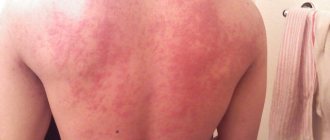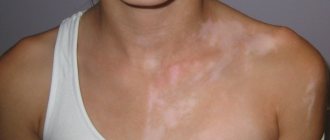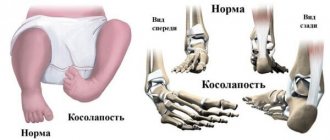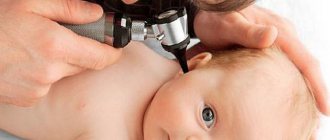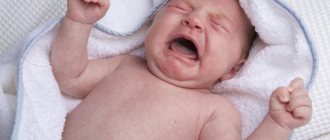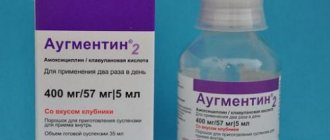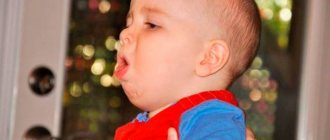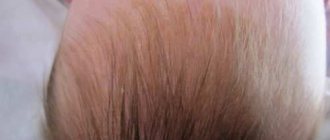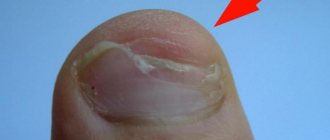2739
Miliaria is a frequently occurring pathology that manifests itself as a rash and redness of the skin or the formation of flesh-colored papules. Miliaria is a reaction of the epidermis to irritation by increased sweat secretions. Many young mothers are concerned about how heat rash in newborns is treated and how it progresses. And are there any differences between the course of this disease in an infant (that is, a child of the first year of life plus/minus six months) and in a newborn (that is, a baby who is less than 28 days old). It's worth looking into.
Features of the newborn period
There are certain significant periods in a child’s life, one of them is the very first, the newborn period. It begins from the moment the baby’s umbilical cord is cut and his breathing and blood flow become autonomous. The newborn period or neonatal period ends at the end of the first month of the baby's life. The essence of this time is the baby’s adaptation to existence outside the womb.
Doctors divide the neonatal period into an early stage (lasts 1-7 days) and a late stage (equal to 7-28 days). All organs and systems of the baby are still immature at this moment - both morphologically and in their functional activity. When a baby is born, an active restructuring of organs and systems begins, its goal is to adapt the baby’s body to existence outside the womb, to external conditions.
A very important feature of the newborn period is the instability of the balance in which the baby’s organs are located. Even minimal changes can affect the child's internal state.
Prickly heat or something else
The work of the sweat glands has not yet been adjusted, so the mother often discovers milia in the baby. These are white dots that appear on the forehead, toes, and cheeks. They are formed due to blocked sweat glands. Milia should never be touched - they will go away on their own in a few weeks. This is not prickly heat!
Another phenomenon with which heat rash in a child is confused is neonatal acne. These are reddish pimples with a whitish purulent tip. They are noticed more often on the face, but they can also be found on the back and neck of the baby. The cause of such rashes is an excess of mother’s hormones in the blood, supported by the still not entirely accurate functioning of the baby’s sweat glands. They go away in two to three months and there is no need to treat them. It is enough to observe hygiene without mistakes. If you are very worried about such rashes of your baby, you can lubricate them with a thin layer of Bepanten from time to time.
The skin of a newborn is supplied with blood much more intensely than that of adults - this is due to the large number of capillaries and their increased diameter. But all damage, if these causes are eliminated, will soon heal. At the same time, the sweat glands are not yet working at 100%.
As a result, the newborn often overheats due to high air temperatures, and also due to very warm vests or diapers.
How does prickly heat manifest?
Skin ailments associated with blockage of sweat glands are characterized by several forms of occurrence. Infants or newborns most often experience a confluent rash of a transparent whitish hue. This type of prickly heat is called crystalline prickly heat, as it stands out as raised areas on the surface of the skin and has fluid-filled blisters.
Foci of inflammation occur not only in places where skin folds form, but in the throat area. Gradually, elements of the rash spread to the face and scalp. For adults with this problem, the entire surface of the body is often affected. The top layer of bubbles is very unstable to mechanical stress, so when they break, the child feels pain. Timely introduction of normal hygiene procedures and proper skin care can easily help reduce the signs of this condition.
Miliaria rubra occurs in adults and children as individually located pimples that look like bright red nodules. Its course is characterized by severe itching. To alleviate the painful condition, external ointments are used while simultaneously maintaining strict hygiene conditions.
The deep form of the disease is characteristic of adults. And it occurs after frequent exposure to prickly heat. The area of skin lesions varies quite widely and can affect not only the body, but also the limbs. During this form of prickly heat, elements of inflammation (up to 3 mm in size) tend to both appear sharply and disappear.
Features of children's skin and prickly heat
A baby's skin is thin and very sensitive - you probably know that it is easily irritated by frequent rubbing and touching. Overheating occurs due to the proximity of blood vessels to the skin. The active work of the sweat glands is marked by the formation of ducts, which is why disturbances in sweating occur.
The causes of prickly heat in children are imperfect thermoregulation and overheating. At the same time, it is not necessary to wrap your baby up for several days in a row: the skin reacts to overheating very quickly. Therefore, prickly heat in a newborn is considered a common occurrence.
Types of miliaria:
- Red. There is hyperemia near the nodules and vesicles, but they do not merge with the rash. Miliaria is fixed on the neck, in the groin area, in the armpits. This type of heat rash causes pain when accidentally touched and itching. These rashes may last for a couple of weeks.
- Crystalline. This is a rash in the form of silvery or whitish blisters. They can be on the face, on the neck, on the back, etc. The bubbles merge and form large spots. Peeling occurs in areas of burst formations. This type of rash does not cause pain or discomfort to the baby, and disappears after a day or two.
- Papular. It is a consequence of increased sweating in the baby, such heat rash is noticeable after a few hours. The formations are flesh-colored; they are fixed on the arms and legs, on the back and in the groin. After some time they disappear on their own; such heat rash in a newborn does not need to be treated, just maintain hygiene.
- Miliaria infected. This is what advanced cases of sweating sickness are called if adults did not react in time. This pathology is complicated by the entry of pathogens into the vesicles, which causes the skin tissue to become infected. There is redness on the skin, blisters fill with a yellowish-gray liquid, and it smells bad. At the same time, the baby’s temperature may rise, which is a symptom of the continuation of the infectious process.
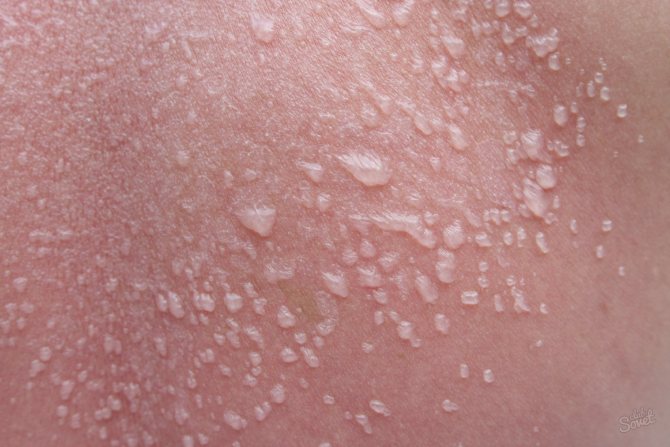
Infected miliaria is dangerous; other cases cannot be called complex. But quite often, parents confuse a baby’s heat rash with an allergy.
MUTRINA - WHAT TO TREAT
— Alla Anatolyevna, how do you feel about home self-treatment of prickly heat?
— In case of any rashes, changes in skin condition, blisters or redness, it is better to visit a doctor. If it is not possible to quickly get an appointment, you can try to help the child yourself. But the lack of improvement is always a reason to consult a pediatrician (and for adults, a dermatologist).
— How to get rid of heat rash in a newborn?
— Miliaria is not a very dangerous disease and does not affect health. But the condition is unpleasant - unsightly red spots, itching, dryness, burning. If prickly heat is noticed in time, there are no purulent complications from the skin fatty tissue, treatment is started early, everything goes away within 7-10 days.
How to distinguish heat rash from allergies
Miliaria is indeed similar to other dermatological ailments. And it is very important to distinguish in time whether a child has heat rash or an allergy.
If the rash is due to an allergic reaction:
- The baby's skin itches, and he tries in every possible way to communicate this - he cries, spins, cannot sleep, reacts to touch;
- The rashes persist even if you take treatment measures. Miliaria quickly responds to treatment - even ordinary air baths reduce the volume of rashes, while allergies give the desired reaction only to adequate treatment and elimination of the allergen;
- If the baby is given an antihistamine, the allergic rash goes away;
- Diathesis rashes resemble scales, and are most often located on the cheeks and limbs.
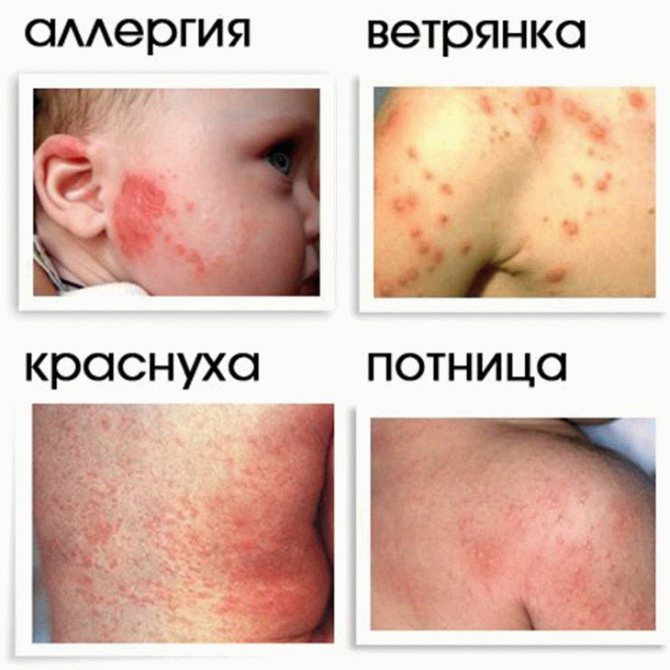
You can see what prickly heat looks like in infants in the photo. If you have any doubts about what it is, it is better to call a doctor. And be sure to think about the cause of the rash. For example, you introduced a new complementary food - then the rash may be an allergy to this product. Or an allergic reaction could be a consequence of having a furry pet at home.
Symptoms of prickly heat
To recognize prickly heat, you can look at the photo. You should also pay attention to the baby’s behavior and the condition of his skin in the neck area.
Symptoms of this phenomenon include:
- poor child's sleep;
- the desire to constantly scratch the affected areas, especially if the room temperature is warm;
- a rash that appears on the neck in the form of small red nodules with a watery structure;
- excessive irritation in the cervical folds, which become warm and moist to the touch;
- noticeable red stripes, reminiscent of scratch marks.
Young children are more likely to experience these signs. So prickly heat on the neck in newborns is considered the most common problem.
Why does sweat rash appear?
Miliaria in infants forms in those places where it is more difficult for air to reach. If you wrap a child without taking into account temperature indicators and the season, if you swaddle the baby too tightly (grandmothers are especially guilty of this), overheating will be a natural consequence of such actions, and then sweat rash will appear. The sweat glands produce a secretion that cannot simply evaporate due to the lack of air. And it accumulates excessively, to which the skin reacts with a reaction such as prickly heat.
Why else does this problem occur:
- The room is very hot, stuffy and/or humid - and this circumstance is very common, so you need to carefully monitor the indicators in the room, ventilate it in a timely manner and do a quick wet cleaning every day.
- Rare bathing. The sun, air and water are truly the first friends for a growing organism. The baby needs to be bathed every day. But this is not washing with soap and gels, when the poor child cannot frolic in the water, but lies in the bathtub covered in foam and suffers. This is precisely bathing, when the baby’s body is immersed in water, he enjoys this contact, he feels pleasant and good. You need to wash your baby with soap no more than 1-2 times a week, because he doesn’t run around the streets yet and just doesn’t get dirty.
- Passion for fatty creams. Preparing for the birth of the baby, mother buys various care products for baby skin. And he makes a big mistake: apart from diaper cream, powder and baby soap, a baby under 3-5 months does not need anything. Fatty creams, and even more so oily lotions, clog skin pores and prevent the epidermis from breathing. This also impairs heat transfer.
- Negative reaction to diapers. For example, they are too small for a baby, they pinch and rub, and that’s what causes heat rash in the baby. But more often than not, parents do not change their baby’s diapers on time, and their contents lead to skin irritation.
- Refusal of air baths. Can't do without them! They will simultaneously prevent prickly heat and treat it. Just after the next diaper change, wash your baby, wipe him dry and leave him naked on a safe surface. It is advisable to take air baths in a ventilated room, the procedure time is 10-15 minutes (later – 30-35).
- Tight and very warm clothes. A child who is going for a walk should not resemble cabbage. He definitely doesn’t need a hundred clothes. We looked at how we dressed ourselves and added another layer - this is how you should dress your baby. Just in case, take a blouse or light blanket with you.
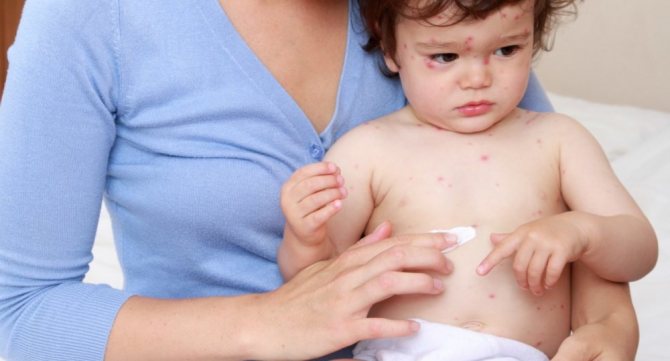
The causes of heat rash contain the answer to the question of how to deal with it. Usually, correcting a problem does not imply treatment as such: you simply focus on hygiene.
If you still think that intensive care for your baby does not give the desired result, before treating heat rash in newborns, find out the opinion of your pediatrician.
Treatment
Treatment of prickly heat on the butt involves:
- The air temperature is around 20 degrees . To regulate the temperature, you need to purchase special regulators for the heating system. They help lower the temperature to the specified levels.
- Air humidity 50-70% . Humidity is measured using a hygrometer. To create the desired climate, use a special device that humidifies the air.
- Clothing made of breathable fabrics . Dress your baby only according to the weather. Choose clothes from natural materials. Avoid synthetic clothing.
- Bathing . To get rid of prickly heat on a baby’s bottom, you need to bathe him daily, but without using soap. For baths, it is recommended to use various decoctions of medicinal plants. It can be string, chamomile, sage. Older children should take baths with a decoction of celandine. Herbal baths should not be prolonged. It is better to reduce the time of water procedures to 5-10 minutes. It is recommended to alternate baths: one day just in water, and the next with herbs.
Any actions when treating prickly heat on the bottom must be agreed with a pediatrician.
Use of medications
The main point that you need to pay attention to when choosing a product to combat heat rash on the butt is its slight drying effect. It is necessary to use only those products that dry the dermis and recreate the protective layer.
Most often, for prickly heat on the bottom of a baby, doctors prescribe the following remedies:
- Bepanten . Apply the product only after swimming or air baths on the dried epidermis. There are no restrictions on the number of cream applications per day.
- Sudocrem . The basis of the drug is zinc oxide. Characterized by water-repellent properties. Approved for use in children of any age.
- Zinc ointment . Distribute the product evenly over the affected area 1-2 times a day in a loose layer.
- Drapolene . The active ingredient is benzalkonium chloride. It has a pronounced antiphlogistic effect. The protective layer lasts for several hours.
- Dexianthene . This is a cream, gel, solution for external use. It is characterized by a pronounced antiphlogistic property.
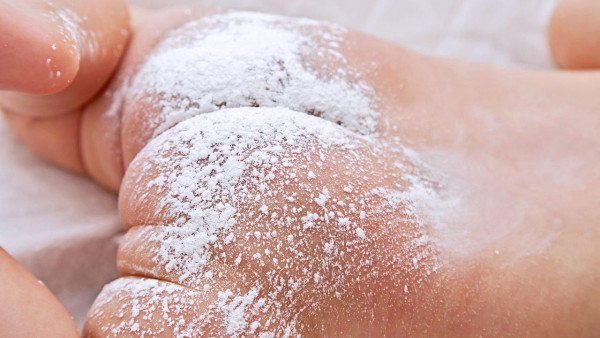
If pustules begin to appear on the baby’s bottom, then antibiotics are indicated. These are erythromycin ointment, Levomekol, Baneocin.
When to call the doctors
If you see pustules and cracks on your baby’s skin, or notice that he is too whiny and won’t let you touch him, be sure to call a doctor.
Consultation with a specialist is necessary if:
- You notice swelling on the baby's body;
- The blisters on his skin have an unpleasant odor, cracks have formed on the dermis;
- The baby signals pain, burning and itching in every possible way;
- The child's body temperature has increased.
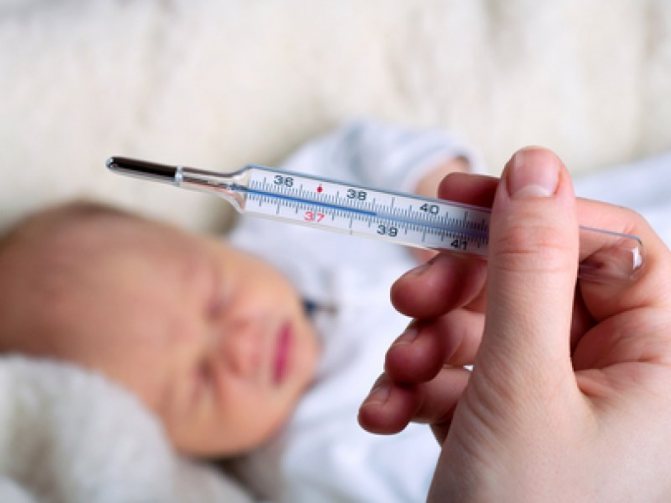
These signs may indicate an infection that has joined an existing illness. Do not wait for the condition to stabilize on its own - purulent formations and cracks are already dangerous and require treatment.
What is prickly heat?
A sweat rash can appear in any area of a little person’s body, where the baby is hot, he sweats, or his skin is exposed to dampness (drool, urine, liquid feces):
- on the face
- armpits
- in the natural folds of the body
- on the butt and groin area
Causes of rashes:
- immaturity or malfunction of the sweat glands
- increased secretion
- overheat
- long-term exposure to conditions of excessive humidity and high temperature
- hyperthermia
- use of clothing and bedding made from synthetic fabrics
- use of low quality disposable diapers
Symptoms of prickly heat
- multiple punctate erythematous redness
- localization of bubbles with transparent or slightly cloudy contents
- some types of prickly heat may be accompanied by itching
- on the face, the rash is localized in places of high humidity - the chin, temples and ears. A rash on a baby’s cheeks is most often allergic.
What medications are used to treat prickly heat?
Medicinal ointments help in some cases, but in others they only worsen the situation. For example, if a child has a slight heat rash, and you smear a thick layer of Drapolene or Bepanten on his skin, you can create the very environment that is optimal for the progression of the disease.
What medicinal ointments are often used for heat rash:
- Bepanten is a cream with regenerating properties that well moisturizes damaged epidermis. An alternative would be the less expensive Drapolene.
- Sudocrem. It dries out rashes well and has an antibacterial effect. It treats heat rash well. But it needs to be applied pointwise to the epidermis, since the consistency of the product is very oily.
- Zinc ointment. It dries out the rash quickly and efficiently, allowing you to cope with the disease in about a day and a half.
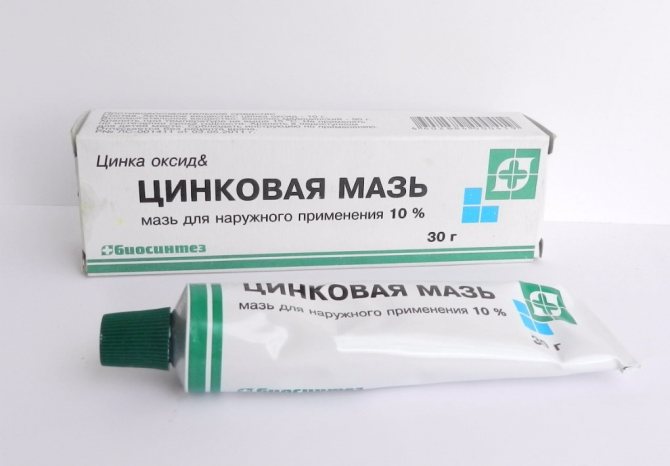
But still, children's doctors warn parents: do not rush to use creams. Why does a child need medications if the illness can be eliminated without them? Start treatment with frequent air baths and strict adherence to temperature and humidity indicators. Bathe your baby every day (twice in hot weather).
After bathing, gently pat your baby's skin dry without rubbing. After drying, apply powder to problem areas. Just don’t pour it out of the jar, but apply it with a cotton swab. There should be no powder in wet areas (in areas of diaper rash). This product is only suitable for dry areas. If serious diaper rash occurs, the baby should be shown to a pediatrician.
Causes and mechanisms
The heat on the head itself is a skin irritation. A similar situation occurs as a result of exposure to sweat: excessive secretion or slow evaporation. In a child, this is provoked by the following factors:
- High temperature and humidity in the room.
- Excessive wrapping.
- Fever.
If we take into account the physiological characteristics of newborns and infants (imperfect thermoregulation), then the appearance of prickly heat will become a completely understandable phenomenon. However, excessive care of parents with fear of hypothermia, and, as a result, constant dressing of caps and hats for the child, only aggravates the situation. Poor skin care and infrequent bathing also cause heat rash.
Increased sweat production and insufficient evaporation from the skin against the background of thermoregulatory immaturity are the main mechanisms for the formation of prickly heat in young children.
How to avoid heat rash
Even in hot weather, you can create comfortable conditions for a newborn. Always dress your baby strictly according to the weather, do not overwrap him or swaddle him tightly. Choose loose-fitting clothes for him, only from natural materials, so that the baby’s skin can breathe.
Also follow these recommendations:
- Water treatments – every day, choose the time individually;
- Air baths – also daily;
- There will be no prickly heat on the head if you limit the use of hats;
- Diaper cream is necessary, but it does not need to be applied every time;
- To wash your baby’s clothes, choose special phosphate-free powders.
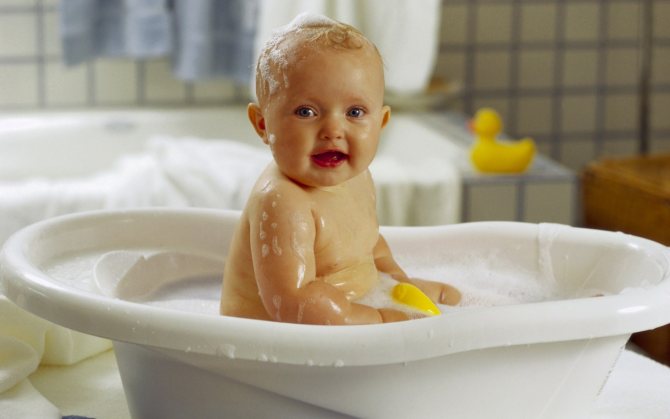
During the walk, monitor the baby’s condition; if he is already wet, his back is wet, there is sweat on his neck and natural folds, end the walk. Carry baby wipes with you, or better yet, a bottle of water and pieces of natural fabrics. If the baby is sweating, wipe his skin with a wet napkin, and change the vest to a dry one (carry a replacement with you). This way you will prevent your baby from prickly heat and its complications.
How to avoid heat rash?
Preventing the appearance of prickly heat is much easier than treating it for a long time. We wrote about heat rash in adults here.
Prevention includes observing the temperature regime in the room, daily hygiene procedures, bathing the child several times a day in the summer, using minimal diapers, arranging air baths, buying clothes made from cotton materials, and not using oil creams that clog pores.
In conclusion, I would like to add that the appearance of prickly heat is due to mistakes in caring for the child by their parents. Carefully monitor the temperature in the apartment and carefully choose your children's wardrobe. Bathe your baby daily and at the first signs of heat rash and redness, immediately treat them with special creams. Only thanks to your attention and love will the baby not encounter such a problem as prickly heat.
